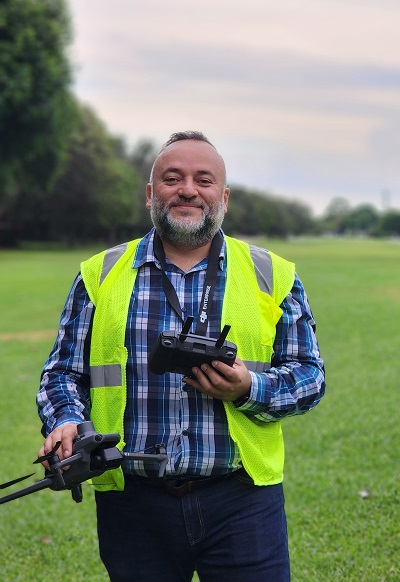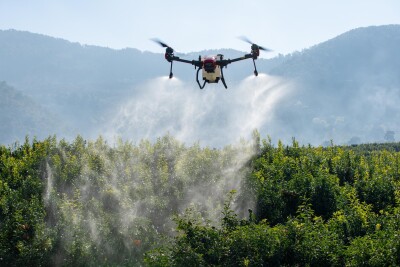The year 2023 marked the official arrival of artificial intelligence (AI) in the headlines of every major newspaper and online publication around the world. For the first time, the promise of AI—and the fears associated with its potential overreach—touched the non-technical citizens who, until now, had been ignoring the subject. Well, ignore no more; AI is here to stay, and for those who have been working in their respective fields to add analytical capability to their workflows, the arrival of artificial Intelligence in the limelight is no surprise, it was inevitable.
We had the fortune of connecting with someone who has been involved in the addition of tools such as machine learning and AI in the field of precision agriculture, Daniel Candro.
“From the early years of agriculture, humans have relied on their hands and physical strength to carry out various activities in the agricultural cycle, including harvesting, planting, and yielding their own food,” Candro reflected. “While the fundamental nature of these activities has remained largely unchanged for hundreds of thousands of years, they have become increasingly efficient over time. Different techniques and technologies have been introduced at various stages throughout the history of agriculture. Similarly, as the Romans designed and innovated agricultural techniques by introducing new elements to established processes, farmers today are more interested than ever in integrating and improving the cyclical process of agriculture.”
The current challenge lies in feeding nine billion people with the same amount of land we had 100,000 years ago. This requires adding technologies and fine-tuning processes that have been in place for millennia.
“Precision agriculture is built upon tools, sensors, software, Internet of Things (IoT), and a wide range of efforts aimed at transforming data into valuable insights. The primary objective of collecting this data is to derive tangible benefits and solutions for real-world agricultural challenges,” Candro said. “In my initial foray into drone usage, I focused on the harvest and crops of potatoes, pastures, and rice in various locations across Colombia. Through research and data collection using drones, sensors, and cameras, I sought to implement detailed changes within the agricultural cycle with great results up to 20% net revenue increase and reduction in water and agrochemicals usage.”
In 2022, Daniel completed a master's degree in project management, specializing in the integration of artificial intelligence and drone technology into farm and crop management.
“My goal at the time was to achieve a consistent increase in revenue, efficiency, productivity, and a deeper understanding of the land through improved crop analysis supported by hard data turned into actionable information,” Candro said. “It is important to recognize that the effective treatment and action plan for information acquired by drones will ultimately become the most powerful tool and a competitive advantage that will truly differentiate decision-making in land and crop management. So how do we accomplish this? First, it is important to recognize that drones, sensors, multispectral and RGB cameras provide an until-now unknown perspective of the land. The images captured by these devices reveal differences that are undetectable to the human eye due to the spectral properties of these light emissions.”
Soon, Daniel realized that to effectively utilize these tools, farmers and agricultural professionals had to familiarize themselves with the terrain and factors such as altitude, selected crop, and soil types.
“Selecting the appropriate sensor or camera is essential to gather the most accurate information relevant to our specific purposes in the field. Taking these considerations into account, we can then plan our flight missions to collect valuable data over time,” Candro emphasized. “Once the data is captured, we can rely on software, analysis tools, our own previous experience, and outside experts such as agronomists to interpret the data; this is the phase in which artificial intelligence plays an important role. As a simple explanation, we can use supervised learning through regression and classification, depending on the specific objectives and applications that we are after.”
AI is a relatively new field in commercial and industrial applications and, as such, every expert in their respective field is testing the boundaries on how this revolutionary technology can be used to streamline workflows and fine-tune processes that have been in place for a long time.
“Supervised learning through regression is used to predict or estimate numerical values, such as expected crop yield, future crop events, or crop performance. On the other hand, supervised learning through classification is used to assign objects or data to specific categories or classes, such as plant disease detection or crop classification based on type,” Candro said. “In summary, precision agriculture can employ both approaches, depending on the specific problems and goals of each application. By leveraging artificial intelligence and using datasets of drone-captured images, we can train models using programming languages such as Python. The obtained results allow us to gain deeper insights into crop management, directly impacting the agricultural production cycle.”
The arrival of AI in the spotlight has brought attention to the transformative potential to impact many industries, including agriculture. Candro, already an expert in precision agriculture, now sees the integration of AI and drone technology as a powerful tool to enhance agricultural practices.
“Using drones, sensors, and cameras, we have successfully implemented changes that led to remarkable improvements in production, efficiency, and revenue within the agricultural cycle,” Candro said. “Beside these obvious results, the improvements have allowed us to predict crop yields and detect plant diseases, among other valuable insights. This integration of precision agriculture, AI, and drone technology has the potential to revolutionize the sector, providing farmers and communities with actionable information for effective land and crop management.”
As we move forward, the implementation of AI in precision agriculture will undoubtedly play a pivotal role in addressing the challenges of feeding a growing global population while optimizing resource usage and promoting sustainability. The journey toward a brighter and more efficient future in agriculture has just begun, and with experts like Daniel leading the way, we can expect groundbreaking advancements in this critical field sooner rather than later.















Comments